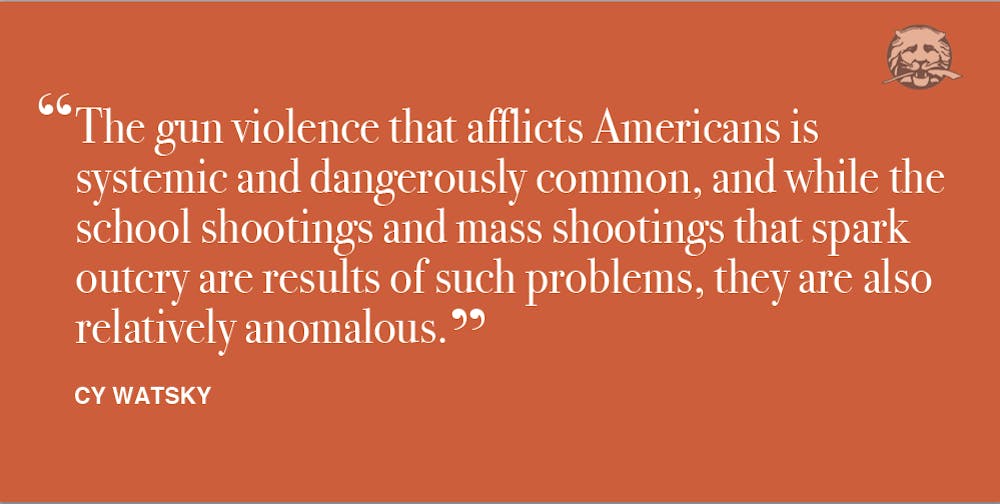The emotional power of the recent March for Our Lives movement is undeniable — the sheer numbers speak for themselves: at least 1.2 million people marched in one weekend. Although unprecedented in scale, it’s also hard not to see the march as a continuation of the horrific cycle that has occupied the U.S. social and political atmosphere for the last few years: a young boy, usually in a relatively well-off suburban neighborhood, terrorizes the local school, killing innocent young (mostly white) children and tearing apart the sense of safety and protection expected in schools. Then, emotional trauma, outrage, and calls to action ensue. And then nothing else substantive happens, and the cycle repeats.
Why does this continue to happen, over and over again? A lot of people point to the powerful gun lobby group, the National Rifle Association, as responsible for the continued rejection of gun control measures. Or, they say that our political discourse is too polarized, and our politicians too unresponsive. While those things are true, I also think there’s a problem with such strong reactions stemming exclusively from these sorts of shootings.
A tiny fraction of the people who die at the hands of guns die in school shootings, and even all mass shootings only make up 2 percent of the deaths due to gun violence. That means that the gun violence that regularly occurs, and kills 96 people every single day, is characterized by suicide and shootings of a couple people at a time. Gun violence disproportionately affects black Americans, while the school shootings that spark the most outrage and national attention, like Sandy Hook and Parkland, are largely white neighborhoods. Most gun violence in America doesn’t involve assault rifles: it’s mostly handguns and shotguns. This is not to say that mass shootings, and school shootings in particular, aren’t horrific, but the other 98 percent of deaths by guns are just as tragic, and much more pervasive. So the movements attacking the American gun problem are stemming from anomalous instances of gun violence, and don’t accurately represent the gun violence that accumulates into the horrifying statistics often pointed to in debating gun control.
Then why do we continue to get upset about school shootings, but not the more common and larger scale instances of gun violence? The answer is complex. Part of it is the sensational nature of these shootings: they are easy to identify and react to, and represent disruptions of what are expected to be safe spaces. Parents send their children to school to learn, not to be killed. Young children are our most vulnerable members of society, and cutting their lives short is tragic. However, the more insidious part of the answer also involves race and class issues: ingrained in our minds is the ideal of a safe, white suburban neighborhood; shattering this ideal is powerful. The unfortunate reality is that we expect these places to be safe, while we are unsurprised at violence that afflicts people of color and poor neighborhoods. People march when lives are lost in Sandy Hook and Parkland, but not for the daily tragedies of more common instances of gun violence.
It’s unfair that some tragedies seem to capture our attention, while most don’t, but just as problematic are the consequences of having the gun control debate only after school shootings. A lot of the cyclical conversation is about preventing school shootings, and while that is important, the gun control policies we craft cannot just be built around one type of situation, especially if they make up such a small portion of the gun violence that actually occurs. It allows people, especially powerful people like our president and politicians, to engage in unproductive discourse. We shouldn’t only advocate for background checks in the name of preventing school shootings — we should call for them so the tens of thousands of mentally ill people who commit suicides with guns every year don’t find them so convenient and accessible. Otherwise, it would be too easy to argue that “people kill people” or “gun control wouldn’t have stopped that school shooter.” If we advocate for gun control only in the aftermath of school shootings, we’ll end up with arguments for arming teachers, which is not only irresponsible, but even if effective, wouldn’t make a dent in the tens of thousands of people who die due to guns every single year. If we advocate for gun control only in the aftermath of school shootings, we cannot focus on the sort of gun violence that kills tens of thousands, not just hundreds.
To be clear, I am not saying that the movements stemming from the tragedies of school shootings and mass shootings are poorly motivated. They are powerful and inspirational in many ways. But we need to stop only reacting to situations like Parkland. Doing so is problematic and ineffective. The gun violence that afflicts Americans is systemic and dangerously common, and while the school shootings and mass shootings that spark outcry are results of such problems, they are also relatively anomalous. To move beyond this cycle of outrage and inaction, we need to stop only being so reactive to these symptomatic consequences of our gun culture, and to start engaging with the larger-scale issues.
Cy Watsky is a first-year from Princeton, N.J. He can be reached at chwatsky@princeton.edu.








